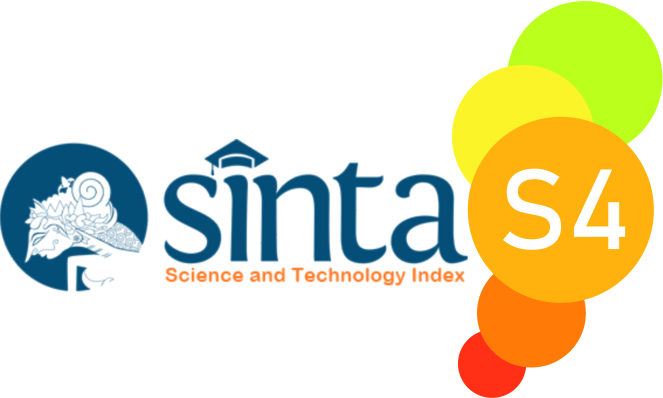The Relationship between OSIS Organizational Activity and Student Learning Outcomes at SMPN 34 Padang City
 ), Wisroni Wisroni(2),
), Wisroni Wisroni(2), (1) Universitas Negeri Padang
(2) Universitas Negeri Padang
 Corresponding Author
Corresponding Author
DOI : https://doi.org/10.24036/spektrumpls.v11i4.124700
Full Text:
 Language : en
Language : en
Abstract
This research is backround by the lack of interest and motivation in learning of students, and students are more preoccupied with student council activities. The purpose of this research is to find out the description and whether there is a relationship between the activeness of student council organizations and student learning outcomes. The type of research used is correlational with a quantitative approach. With a population of all OSIS administrators at SMPN 34 Kota Padang, totaling 36 people consisting of 21 class VII students and 15 class VIII students. While taking samples using stratified random sampling technique. In this study there were two strata, namely class VII and VIII. So, the sample taken is 70% of the class level. Where the sample is 15 class VII and 11 class VIII with a total sample of 26. The data collection technique is a questionnaire or questionnaire. The collected data were analyzed using the proportion formula and rank order. The results of the study show that the results of the research data management and discussion that have been described in the previous chapter, it can be concluded (1) Members and OSIS administrators of SMPN 34 Padang City are included in the active category. Where the level of attendance in OSIS activities is high, is responsible for the position held, dares to provide suggestions, criticism and opinions in good and polite language, has a willingness to sacrifice, and has high motivation to increase self-confidence and potential that exists within. (2) The learning outcomes of students who become members and administrators of the OSIS are modified into the good category with the lowest score of 72.10 and the highest score of 84.70 (3) There is a moderate positive relationship between the activeness of OSIS organizations and student learning outcomes. this is seen from the significant value of 0.002. Where 0.002 <0.05 and the tcount value is 0.586 which is in the medium category.
References
Asih, yuli gusti. (2018). Metodologi Pembelajaran. Semarang University Press.
Asrori, M. (2013). Pengertian, Tujuan dan Ruang Lingkup Strategi Pembelajaran. Madrasah, 5(2).
Dahliyana, A. (2017). Penguatan pendidikan Karakter Melalui Kegiatan Ekstrakulikuler di Sekolah. Jurnal Sosioreligi, 15(1), 54–64.
Fatimah, F., & Sari, R. D. K. (2018). Strategi Belajar & Pembelajaran dalam Meningkatkan Keterampilan Bahasa. Pena Literasi, 1(2).
Hamalik, O. (2017). Proses Belajar Mengajar. Bumi Aksara.
Hardiansah, M. F. (2019). Hubungan Keaktifan Berorganisasi dan Budaya Organisasi dengan Prestasi Akademik Pengurus Himpunan Mahasiswa. Jurnal Pendidikan Ekonomi, Manajemen Dan Keuangan, 3(1).
Hidayat, M. A., Anwar, A., & Hidayah, N. (2017). Pendidikan Non Formal dalam Meningkatkan Keterampilan Anak Jalanan. Jurnal Edudeena, 1(1). https://media.neliti.com/media/publications/240945-pendidikan-non-formal-dalam-meningkatkan-b3d15511.pdf
Jasmalinda. (2021). Pengaruh Budaya Organisasi dan Disiplin Kerja Terhadap Kinerja Karyawan PT. Kereta Api Indonesia (Persero) (Studi Kasus Pada Unit Sarana PT. Kereta Api Indonesia (Persero) Divisi Regional II Sumatera Barat). Jurnal Inovasi Penelitian, 1(11).
Marlina, L., & Sholehun, S. (2021). Analisis Faktor-Faktor yang Mempengaruhi Hasil Belajar Bahasa Indonesia Pada Siswa Kelas IV SD Muhammadiyah Majaran Kabupaten Sorong. Jurnal Keilmuan Bahasa, Sastra, Dan Pengajaran (FRASA), 2(1).
Mulia, A. J., & Setiawati, S. (2022). Hubungan antara Keaktifan Berorganisasi Pustat Informasi Konseling Remaja (PIK-R) dengan Hasil Belajar Siswa Sekolah Menengah Atas Negeri 3 Padang Panjang. Jurnal Family Education, 2(1). https://doi.org/10.24036/jfe.v2i1.43
Nopaldi, A., & Setiawati, S. (2018). Hubungan antara Motivasi Belajar dengan Minat Belajar Warga Binaan pada Keterampilan Menjahit di Panti Sosial Karya Wanita Andam Dewi Solok. Spektrum: Jurnal Pendidikan Luar Sekolah (PLS), 1(4). https://doi.org/10.24036/spektrumpls.v1i4.101463
Patunru, S., Jam’an, A., & Madani, M. (2020). Analisis Keaktifan Berorganisasi Terhadap Prestasi Akademik Mahasiswa Program Studi Teknologi Laboratorium Medis Politeknik Kesehatan Muhammadiyah Makassar. Competitiveness, 9(2).
Raharjo, T. J. (2005). Peran Seni Proses Pembelajaran Pendidikan Luar Sekolah. Harmonia: Jurnal Pengetahuan Dan Pemikiran Seni, VI(2).
Safitri, M., Wisroni, W., & Jalius, J. (2018). Hubungan Persepsi Warga Belajar Terhadap Strategi Pengelolaan Tutor dengan Hasil Belajar Pada Kejar Paket C di PKBM Merah Putih Kecamatan 2x11 Kayutanam. SPEKTRUM: Jurnal Pendidikan Luar Sekolah, 1(1). http://ejournal.unp.ac.id/index.php/pnfi/article/view/9519/101619
Santoso, I. B. (2019). The Impact of the Activities Organization and Learning Motivation on Learning Achievements of Yogyakarta State University Students 2019/2020 Period. Jurnal Ilmu Manajemen, 16(2).
Setyaningrum, D. F., Sawiji, H., & Ninghardjanti, P. (2018). Pengaruh Keaktifan Berorganisasi dan Prestasi Belajar Terhadap Kesiapan Kerja Mahasiswa Program Studi Pendidikan Administrasi Perkantoran Angkatan 2013 Universitas Sebelas Maret Surakarta. Jurnal Informasi Dan Komunikasi Administrasi Perkantoran, 2(2).
Slameto, S. (2010). Belajar dan Faktor-faktor yang Mempengaruhinya (R. Cipta (ed.); 5th ed.).
Sugiyono. (2017). Metode Penelitian Kuantitatif Kualitatif dan R&D. Alfabeta.
Sunarti, V. (2014). Peranan Pendidikan Luar Sekolah dalam Rangka Mitigasi Bencana. Spektrum: Jurnal Pendidikan Luar Sekolah (PLS), 2(2). https://doi.org/10.24036/spektrumpls.v2i2.5044
Suryosubroto, B. (2002). Pengaruh Keaktifan Mahasiswa dalam Organisasi Terhadap Prestasi Belajar Mahasiswa Jurusan Pendidikan Ekonomi Fe Unesa. Jupe, 6(2).
Susanti, L., Hasnawati, H., & Zen, W. L. (2022). Pengaruh Kegiatan Ekstrakulikuler Pramuka Terhadap Kedisiplinan Peserta Didik di SMA Negeri 13 Padang. PRODU: Prokurasi Edukasi-Jurnal Manajemen Pendidikan Islam, 4(2).
Syaadah, R., Ary, M. H. A. A., Silitonga, N., & Rangkuty, S. F. (2023). Pendidikan Formal, Pendidikan Non Formal Dan Pendidikan Informal. Pema (Jurnal Pendidikan Dan Pengabdian Kepada Masyarakat), 2(2), 125–131. https://doi.org/10.56832/pema.v2i2.298
Syamsi, I. (2010). Pendidikan Luar Sekolah sebagai Pemberdaya dalam Masyarakat. Diklus, 14(1). https://journal.uny.ac.id/index.php/diklus/article/view/5796
 Article Metrics
Article Metrics
 Abstract Views : 120 times
Abstract Views : 120 times
 PDF Downloaded : 23 times
PDF Downloaded : 23 times
Refbacks
- There are currently no refbacks.

This work is licensed under a Creative Commons Attribution-NonCommercial 4.0 International License.


